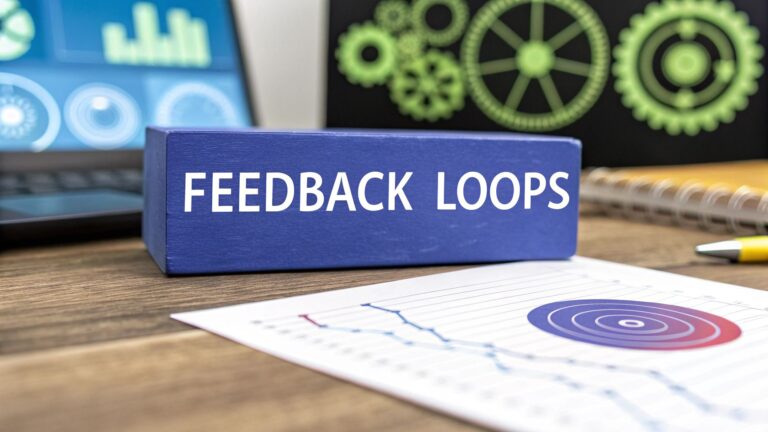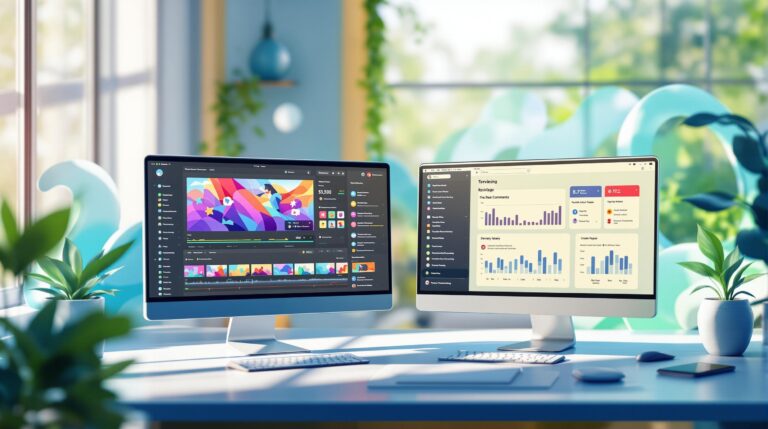Centralizing feedback is essential for remote teams to stay organized and productive. It helps track updates, reduce misunderstandings, and improve collaboration. Scattered feedback across emails or apps can cause delays, version confusion, and lost information. Using a central platform with tools like annotations, real-time updates, and dashboards solves these challenges. Here’s how to make it work:
- Choose the Right Tool: Look for features like file support, annotation tools, and cross-device accessibility.
- Organize Feedback: Use categories like priority levels or project phases to streamline input.
- Establish Clear Processes: Add context to feedback, set deadlines, and track progress on a centralized dashboard.
- Address Time Zones: Use overlap hours or flexible feedback windows for global teams.
- Promote Adoption: Start with a pilot group and offer practical training to ease the transition.
How to deliver feedback remotely when coaching a sales team
Setting Up a Centralized Feedback System
Creating a feedback system for remote teams requires the right tools and clear processes to ensure smooth collaboration, no matter the time zones or team structures. Here’s how to build a system that keeps everyone aligned.
Choosing the Best Tool for Your Team
The backbone of any feedback system is the platform you use. Look for tools that align with your team’s needs. Key features to consider include:
| Feature Category | Requirements | Why It Matters |
|---|---|---|
| File Support | Handles PDFs, images, videos, etc. | Makes feedback possible across all types of projects |
| Annotation Tools | Text and drawing capabilities | Links feedback directly to specific elements |
| Real-time Updates | Synchronized dashboard | Keeps everyone up-to-date instantly |
| Accessibility | Works across devices and platforms | Ensures everyone can participate |
Once you’ve nailed down the right tool, it’s time to streamline how files and feedback are managed.
Uploading Files and Adding Clear Annotations
Centralizing annotations keeps feedback organized and avoids confusion. Here’s how to make your feedback process as clear as possible:
- Prepare files so they’re ready for review.
- Pinpoint the exact areas that need changes.
- Add context to each annotation by explaining the "why" behind the suggestion.
- Label feedback by urgency or priority to help the team focus on critical tasks.
For example, instead of vague comments like "fix this", be specific: "Adjust the text size to improve readability on mobile devices." This clarity ensures the feedback is actionable and avoids unnecessary back-and-forth.
Sharing Feedback and Tracking Progress
A streamlined system for sharing feedback and monitoring updates is essential. A centralized dashboard can act as your go-to for keeping everything on track.
To make feedback actionable:
- Share annotated project links with clear deadlines for implementation.
- Use the dashboard to monitor progress and check off completed tasks.
- Hold regular check-ins to address questions and ensure alignment.
This approach ensures feedback is not only shared but also acted upon efficiently.
Best Practices for Centralizing Feedback
Scheduling Regular Feedback Meetings
Remote teams thrive on consistent communication. Regularly scheduled meetings like bi-weekly team reviews, monthly one-on-ones, and sprint retrospectives help keep everyone aligned. Here’s an overview of their purpose and timing:
| Meeting Type | Frequency | Purpose | Duration |
|---|---|---|---|
| Team Review | Bi-weekly | Discuss project progress and feedback | 45-60 min |
| One-on-One | Monthly | Focus on individual performance | 30 min |
| Sprint Retro | End of Sprint | Reflect on processes and team dynamics | 60 min |
These meetings create a structured way to share insights, but effective communication is key to making the feedback actionable and clear.
Ensuring Clear and Open Communication
Clear communication is the backbone of any feedback system. Tools like the SBI (Situation-Behavior-Impact) framework, documenting decisions, and assigning timelines and task owners make feedback more organized and actionable.
BugSmash’s annotation features simplify this process by letting teams leave direct, contextual feedback on work items. This eliminates the confusion that often comes with vague, text-only comments.
By prioritizing clarity, teams can build a feedback process where ideas and insights move smoothly across projects and departments.
Establishing a Feedback Loop
A strong feedback loop ensures ongoing improvement by tracking input, measuring results, and ensuring follow-through.
"Creating opportunities for employees to provide upward feedback helps leaders understand the remote work experience and fosters open communication across all levels of the organization." [1]
Key elements of a feedback loop include:
- Version Control: Keep a clear version history so team members can see how their feedback influences the final outcome. This transparency encourages participation.
- Track and Measure Progress: Use centralized dashboards to monitor how quickly feedback is implemented and identify any delays. This data can highlight areas needing improvement.
sbb-itb-54a62c3
Addressing Common Challenges in Feedback Centralization
Handling Time Zone Differences
Time zone differences can make centralizing feedback tricky for remote teams. Instead of relying on everyone to respond immediately, try setting flexible feedback windows. For instance, a 24-hour feedback period for critical reviews allows everyone to contribute without the pressure of real-time responses.
Another approach is using overlap zones – specific time slots when team members across regions can connect for live discussions. Here’s an example of how this might look:
| Region | Available Hours | Overlap Period |
|---|---|---|
| Americas (EST/PST) | 9 AM – 5 PM EST | 2 PM – 4 PM EST |
| Europe (CET) | 9 AM – 5 PM CET | 8 AM – 10 AM EST |
| Asia-Pacific (APAC) | 9 AM – 5 PM SGT | 8 PM – 10 PM EST |
By planning around these time slots, teams can keep feedback flowing smoothly, no matter where members are located.
Gathering and Organizing Scattered Feedback
Feedback often comes from various sources – emails, chats, or shared documents – which can make it hard to manage. To simplify things, sort feedback into clear categories like:
- Priority levels: Critical, Major, Minor
- Project phases: Design, Development, Testing
- Implementation status: New, In Progress, Completed
This structure helps teams track and act on feedback more efficiently, ensuring nothing falls through the cracks.
Encouraging Adoption of New Systems
Switching to a new feedback system can be tough when teams are used to their current tools. Start small with a pilot group of eager participants to demonstrate the system’s benefits. Show how it reduces delays or makes task assignments clearer – quick wins like these can win over skeptics.
Offer hands-on training sessions that focus on practical tasks, such as:
- Uploading and organizing files
- Adding detailed annotations and comments
- Monitoring progress on feedback tasks
- Generating clear, actionable reports
These steps can help teams feel confident and comfortable with the new system.
Integrating Feedback Centralization into Team Culture
Incorporating Feedback into Daily Work
Make feedback a natural part of your team’s daily routines. For instance, when developers push updates or designers finish mockups, they can upload their work to BugSmash for immediate review. This keeps feedback flowing right within the workflow.
Here’s how feedback fits into different project stages:
| Project Stage | Feedback Integration Point | Action |
|---|---|---|
| Planning | Requirements Review | Share briefs for team input |
| Development | Sprint Reviews | Test and share prototypes |
| Design | Iteration Reviews | Submit designs for feedback |
| Testing | QA Sessions | Log bugs directly for fixes |
By weaving feedback into every step of a project, teams can stay aligned and continually improve their work.
Promoting a Continuous Feedback Culture
Creating a culture where feedback thrives is key to long-term success. The SBI (Situation-Behavior-Impact) model is a great tool for crafting clear, actionable feedback. For example, instead of saying, "The design needs work", you can use BugSmash to pinpoint specific issues, like a mobile visibility problem in the homepage hero section.
"Creating opportunities for employees to provide upward feedback helps leaders understand the remote work experience and fosters open communication across all levels of the organization." [1]
This kind of open dialogue strengthens team dynamics and ensures everyone feels heard.
Using Technology to Support Collaboration
BugSmash’s real-time updates, version tracking, and annotation tools make collaboration easier by centralizing feedback. This is especially helpful for remote teams, where clear communication is critical. By cutting down on miscommunication, teams can focus their energy on being creative and solving problems.
To keep things organized, set up project templates and feedback categories ahead of time. This makes gathering and applying feedback smoother, while also encouraging everyone to contribute their thoughts regularly.
Conclusion and Key Points
Centralizing feedback plays a crucial role in helping remote teams tackle scattered communication and enhance collaboration. Tools like BugSmash bring all input into one place, making it easier to stay organized and aligned. This approach ensures feedback isn’t lost or ignored, keeping everyone on the same page.
Three main elements drive the success of centralized feedback:
- Technology: Tools that simplify collaboration and unify communication.
- Structured methods: Frameworks like SBI help make feedback clear and actionable.
- Integrated feedback loops: Consistent feedback at every project stage.
Remote teams can overcome challenges like time zone differences, scattered feedback, and adoption hurdles by balancing structure with flexibility. While organized feedback systems are important, teams also need to adapt to individual preferences and work styles [1].
With clear communication, the right tools, and a culture that values feedback, teams can turn obstacles into opportunities. This balance of organization and adaptability allows remote teams to refine their feedback processes as work dynamics shift. As remote work continues to grow, centralizing feedback will remain a key factor in fostering collaboration and improvement.
FAQs
How do you handle feedback and criticism in a remote work setting?
Managing feedback in remote teams requires a mix of clear communication, smart use of tools, and thoughtful planning. Here’s how you can approach it:
Listen and Respond Thoughtfully
When you receive feedback, focus on listening carefully. Assume the feedback is meant to help, and take a moment to reflect before replying. If anything is unclear, ask questions to clarify. Afterward, create a plan with specific steps to address the feedback and share it with your team to ensure everyone is on the same page.
Use Technology to Stay Organized
Centralized tools can simplify feedback management. For instance, platforms like BugSmash help by:
- Keeping all feedback in one accessible place
- Allowing teams to track progress on implementing feedback
On top of using tools, it’s important to address challenges like time zone differences to ensure smooth communication across your team.
Work Around Time Zones
Time zones can make feedback tricky, but structured solutions help. Here are a few methods:
| Strategy | How It Works |
|---|---|
| Asynchronous Feedback | Use tools to share detailed feedback without needing instant replies |
| Overlap Windows | Schedule sessions during hours that work for everyone |
| Recorded Sessions | Record meetings so team members can review them later |
By addressing time zone issues, you ensure feedback flows smoothly, no matter where your team is based.
Check How Well It’s Working
To make sure your feedback process is effective, track key metrics like how often feedback is implemented, how engaged your team is, and how quickly issues are resolved. Regular reviews help you fine-tune the system for better results.



